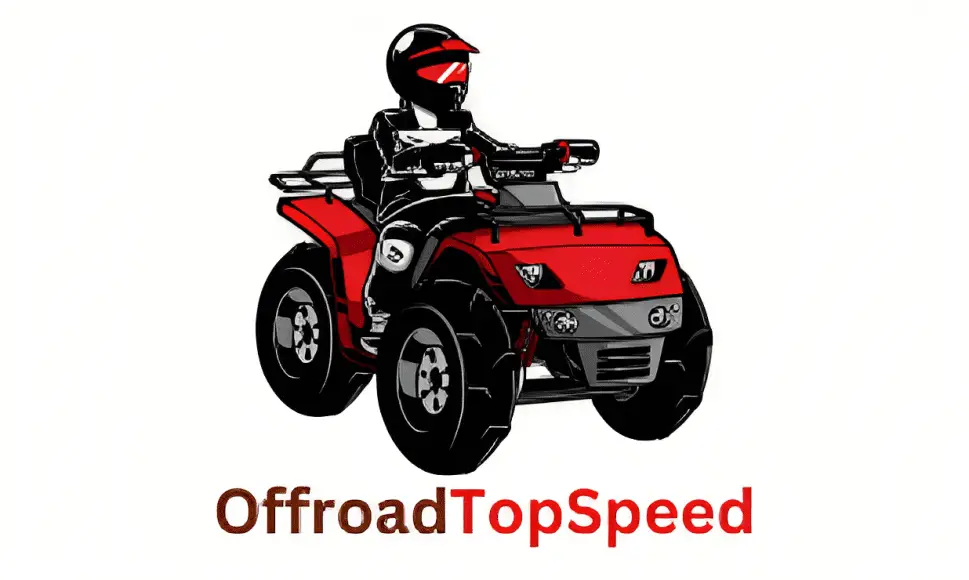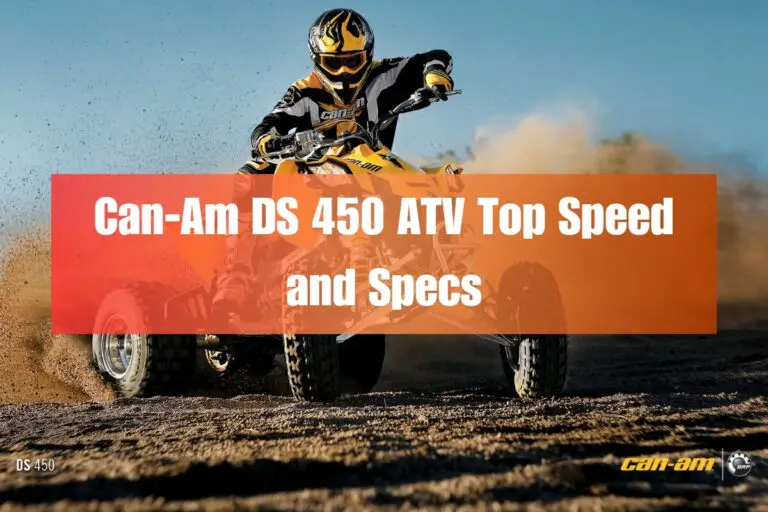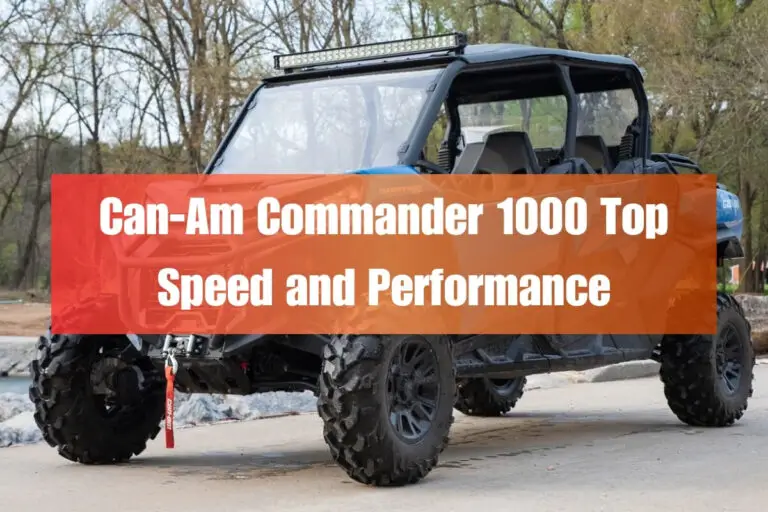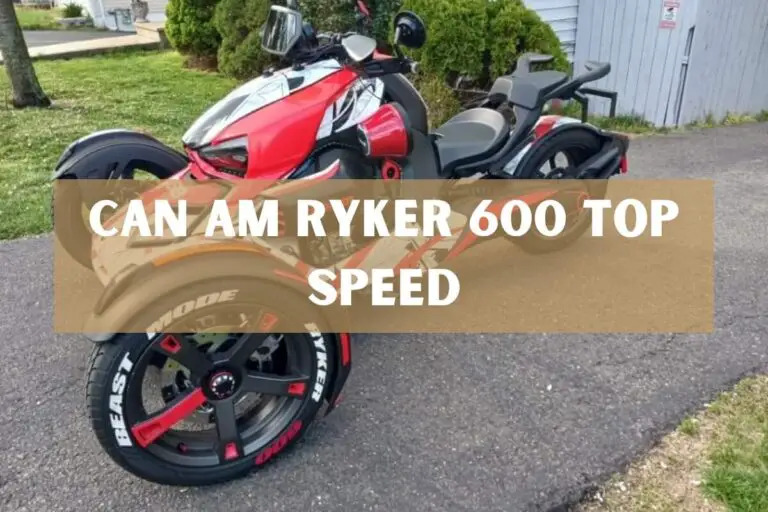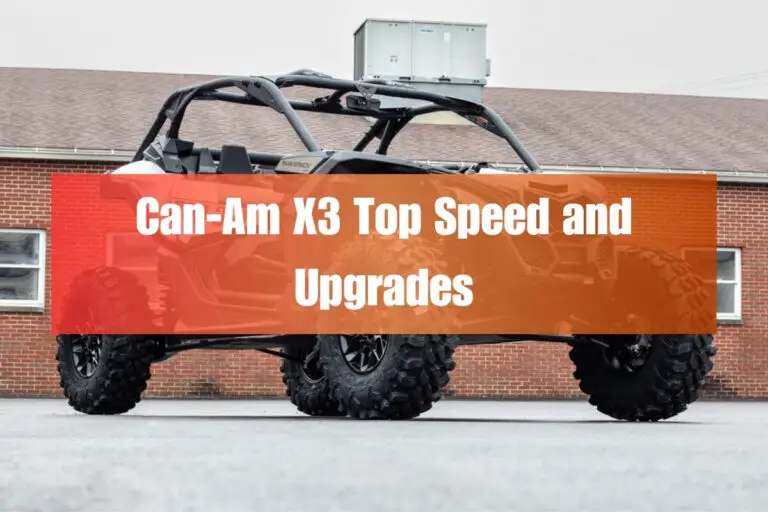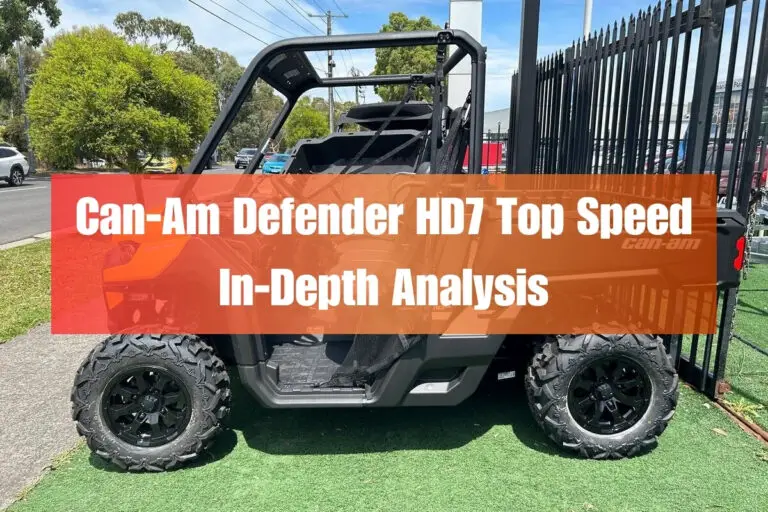can am renegade 1000 top speed: Can Hit 100 MPH?
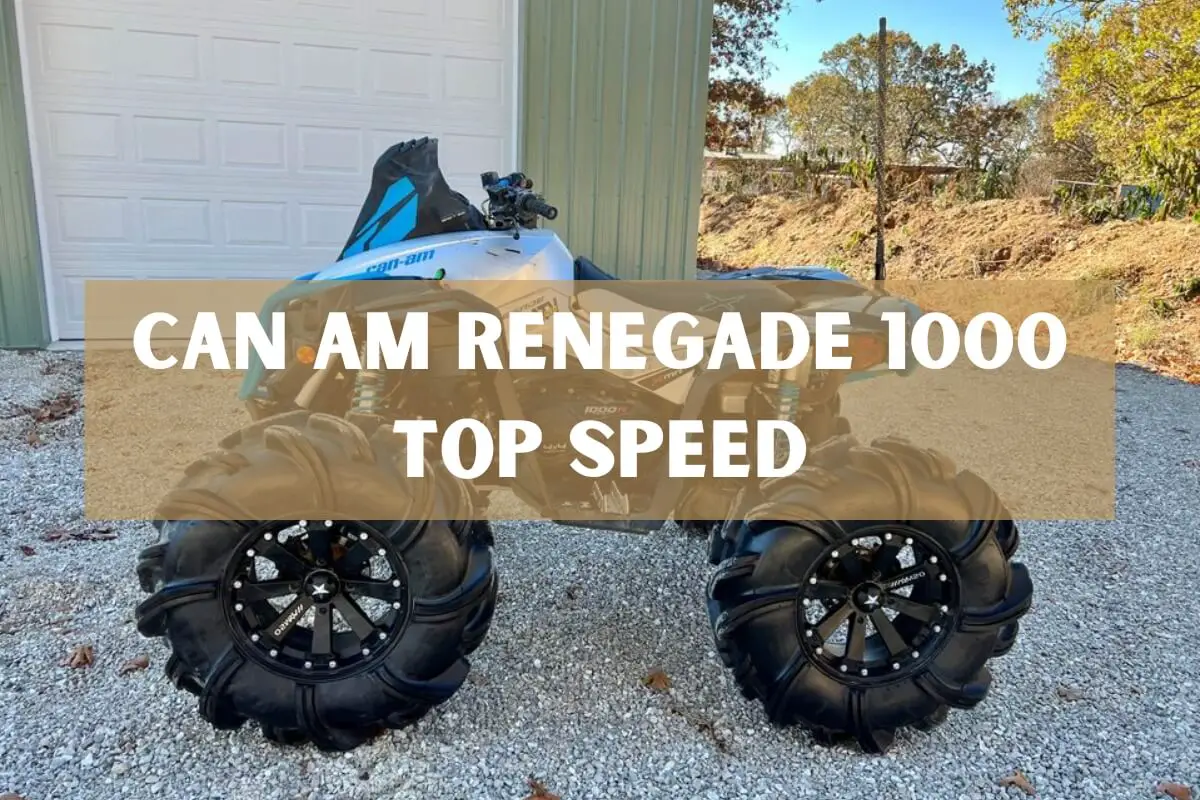
If you are looking for a powerful and fast ATV, you might want to check out the Can-Am Renegade 1000. This quad can reach impressive speeds on any terrain, thanks to its robust engine and agile design.
Depending on the model, the Renegade 1000 can go as fast as 65 mph or 75 mph without any modifications. But with some tweaks and upgrades, you can push this ATV to the limit and possibly surpass 100 mph.
In this article, we will explore the speed potential of the Renegade 1000, how it compares to its rivals like the Polaris Scrambler XP 1000, and how to safely test its performance.
Overview of the Beastly Can-Am Renegade 1000 ATV
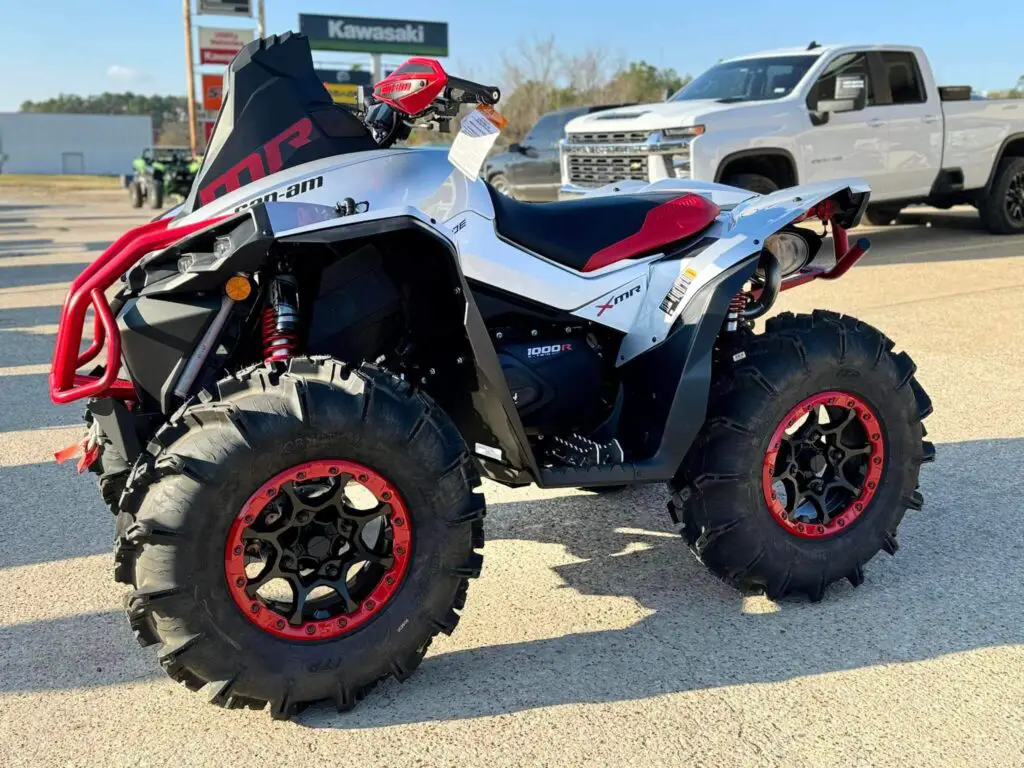
The Can-Am Renegade 1000 is billed as one of the most powerful sport ATVs on the market, with a 976cc Rotax V-twin engine putting out 91 horsepower. This grunt all routes through a continuously variable transmission (CVT) to a selectable 2WD/4WD drivetrain with Visco-Lok front differential and arched double A-arm front suspension.
With a curb weight of 795 lbs, the Renegade 1000 checks all the boxes for exhilarating speed and acceleration. But just how fast can this monster get up to with a little modification and tuning?
Can-Am Renegade 1000 Key Specs & Features
| Category | Spec |
|---|---|
| Engine | 91 hp, Rotax 976 cc V-twin, liquid-cooled |
| Fuel Delivery System | Intelligent Throttle Control (iTC) with Electronic Fuel Injection (EFI) |
| Transmission | CVT, P/R/N/H/L, Intelligent Engine Braking (iEBTM) |
| Drive Train | Selectable 2WD/4WD with Visco-Lok QE auto-locking front differential |
| Power Steering | Tri-Mode Dynamic Power Steering (DPS) |
| Front Suspension | Arched double A-arm with front sway bar, 9.2 in. (23.3 cm) travel |
| Front Shocks | FOX 1.5 PODIUM RC2 |
| Rear Suspension | Torsional Trailing arm Independent (TTI), 9.9 in. (25.1 cm) travel |
| Rear Shocks | FOX 1.5 PODIUM RC2 |
| Front Tires | ITP Holeshot ATR 25 x 8 x 12 in. |
| Rear Tires | ITP Holeshot ATR 25 x 11 x 12 in. |
| Wheels | 12 in. cast-aluminum beadlock |
| Front Brakes | Dual 214 mm disc brakes with hydraulic twin-piston calipers |
| Rear Brakes | Single 214 mm disc brake with hydraulic twin-piston caliper |
| Estimated Dry Weight | 795 lb (361 kg) |
| Length x Width x Height | 86 x 48 x 49 in. (218.4 x 121.9 x 124 cm) |
| Wheelbase | 51 in. (129.5 cm) |
| Ground Clearance | 10.5 in. (26.7 cm) |
| Seat Height | 34.5 in. (87.7 cm) |
| Rack Capacity | Rear: 35 lb (16 kg) |
| Storage Capacity | N/A |
| Towing Capacity | 1,300 lb (590 kg) |
| Fuel Capacity | 5.4 gal (20.5 L) |
| Gauge | 4.5 in. digital display |
| Instrumentation | DC outlet, 15-A connector |
| Lighting | LED headlights |
| Winch | Prewired for available winch |
| Seat | Standard |
| Handlebar | Aluminum taper-profile handlebar with full wrap handguards |
| Protection | Front bumper, Front & central skid plate |
The Stock Can-Am Renegade 1000 Top Speed
In stock factory form with all the electronic engine and speed limiting systems in place, the Can-Am Renegade 1000 is restricted to a top speed of 75 mph (120 km/hr).
But 75 mph still doesn’t quite crack that magical 100 mph mark – an enticing psychological benchmark for many hardcore ATV enthusiasts pushing for ultimate velocity.
The good news is the Renegade 1000 definitely packs the power and performance to potentially reach 100+ mph with the right modifications and optimal conditions. The 976cc Rotax V-twin has muscle to spare beyond what Can-Am allows in stock configuration.
Renegade 1000 Speed & Acceleration Discussion
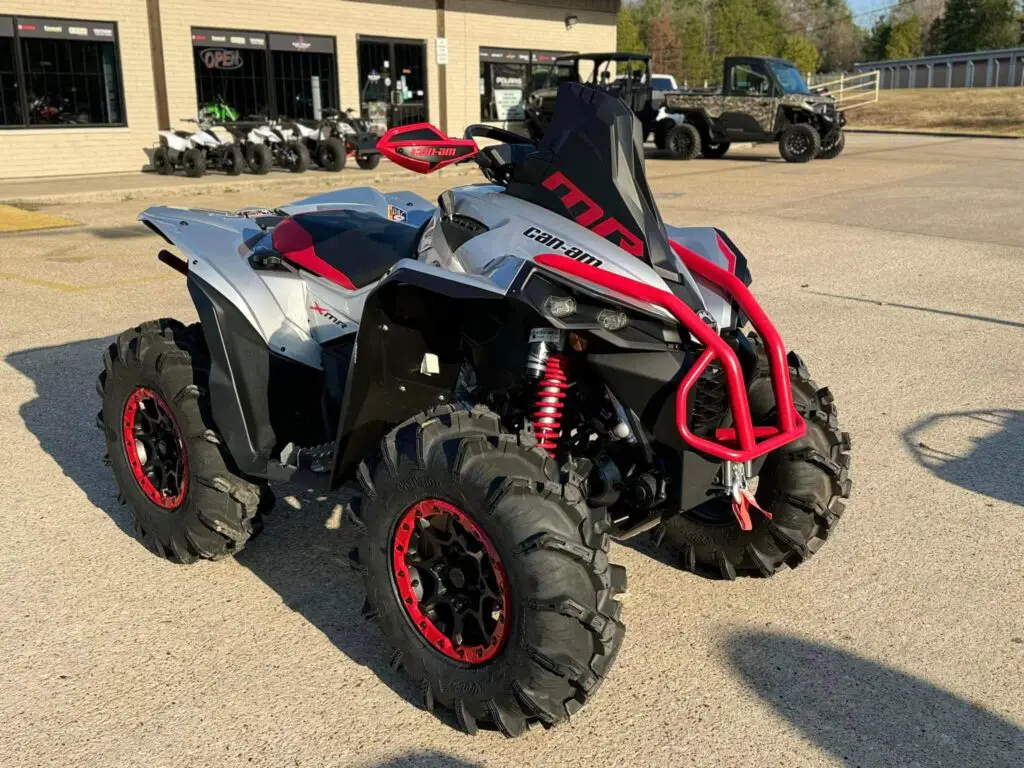
There are several key factors that determine how quickly the Renegade 1000 can accelerate and what top speeds it is capable of:
- Engine Power & RPM Capability – With 91 hp, the Renegade has grunt to spare at lower RPMs. Reaching 100 mph would require extending max RPM capability with ECU adjustments.
- Gearing & Sprockets – The CVT gear ratios and sprocket sizes have a major impact on acceleration rates and how quickly the engine can reach max speed in each gear.
- Rider Positioning – Getting in a tight, leaned forward tuck can lessen aerodynamic drag at high speeds above 80 mph.
- Tire Setup – Stickier 25 x 8 x 12 in front and 25 x 11 x 12 in rear tires optimized for higher speeds could grip better during max velocity runs once weight shifts rearwards accelerating hard.
Aftermarket upgrades to the engine systems, ECU tuning, and gearing modifications can all help extract more speed potential compared to stock configuration if done properly. Of course, safety has to come first!
“The acceleration is awesome, I hit 70 mph in what feels like seconds. Even bone stock this quad hooks up and GOES!” – Renegade 1000 Owner
What’s the Limit? Modded Renegade 1000 Top Speed Estimate
With the stock speed limiter disabled through an ECU tune, plus supporting mods to intake, air filter, exhaust, and fuel mapping, a well set up Renegade 1000 should be capable of reaching 75-85 mph at redline in the right conditions.
Getting much beyond 85 mph is difficult simply due to aerodynamic drag increasing exponentially at higher speeds – that’s a ton of air rushing by while trying to hang on! And the stability and braking power of ATVs like the Renegade 1000 starts getting questionable approaching 75 mph as well.
But the point is the engine itself likely still has some extra grunt that could be extracted with the right build. Just don’t expect to hold WOT for long up around 85 mph on this Can-Am. The limits of traction and chassis stability get pushed hard at that velocity off-road.
Can-Am Renegade 1000 Top Speeds By Model Year
| Model Name | Model Year | Top Speed (mph) |
|---|---|---|
| Renegade 1000R X xc | 2023 | 75 |
| Renegade 1000R | 2021 | 65 |
| Renegade 1000R | 2020 | 65 |
| Renegade 1000R | 2019 | 65 |
| Renegade 1000R | 2018 | 65 |
| Renegade 1000R | 2016 | 65 |
Pros of a Fast Renegade 1000 Setup
- Awesome straight line speed and acceleration
- Ability to stay ahead of rivals on high speed trails
- Huge grins when unleashing the beast!
- Improved dusting capability with velocity
- More passing power and snappier throttle response
Cons of Pushing the Limits
- Safety concerns above 75 mph
- Stability and braking issues at high speed
- Increased wear on engine and drivetrain
- Added costs for tunes and parts
- Voided factory warranty in some cases
Renegade 1000 vs Scrambler XP 1000 S
Renegade 1000
The Renegade 1000 is one of the most powerful and versatile ATVs on the market. It has a Rotax 976 cc V-twin engine that produces 91 hp, a CVT transmission with P/R/N/H/L and Intelligent Engine Braking (iEB), and selectable 2WD/4WD with Visco-Lok QE auto-locking front differential. It also has a sporty design, a seat height of 34.5 in. (87.7 cm), and a ground clearance of 10.5 in. (26.7 cm). The Renegade 1000 can handle any terrain, from trails to mud to sand.
Scrambler XP 1000 S
One of the main rivals of the Renegade 1000 is the Polaris Scrambler XP 1000 S. This ATV has a parallel twin engine that produces 89 horsepower, a continuously variable transmission, and an all-wheel drive system. It also has electronic power steering, Walker Evans 3-Way Adjustable Shocks, and a cargo system of Lock & Ride, 1 gal (4 L) rear storage. The Scrambler XP 1000 S has a seat height of 37 inches, a wheelbase of 57.4 inches, and a width of 55 inches. The Scrambler XP 1000 S can also tackle any terrain, but it is more suited for mud and rocks.
Renegade Owners Sound Off on Speed & Performance
Current and past owners of the Renegade 1000 have shared lots of feedback on real world speed and acceleration with these ATVs. Here’s a sample:
“Bone stock I hit 72 mph on flat ground. Fastest machine I’ve owned, thing absolutely rips!”
“I consistently hit 75+ mph on mine after installing a Muzzy exhaust and DynoJet tuner with the speed limiter disabled. Still pulls hard!”
“The power and speed is awesome, but the lack of stability at those velocities worried me. Fishtailing like crazy at 74 mph after hitting some bumps.”
So while the Renegade 1000 clearly has world-class acceleration and speed potential with its stout Rotax twin, owners do cite some handling concerns when pushing this ATV to higher velocities above 70 mph or so. Compromised stability and braking traction is definitely a risk to weigh carefully.
Safely Testing Top Speed – Closed Course vs. Public Roads
If attempting to explore the upper speed potential of an ATV like the Renegade 1000, it’s absolutely vital to do initial testing only on closed private courses away from public roads or trails until the vehicle is fully sorted.
Sudden stability issues, traction loss from bumps, or the need for urgent braking can all be extremely hazardous at unknown high speeds without run-off room or containment barriers. Always wear full protective gear as well even for closed course speed testing.
Gradually work up to establish safe WOT velocity benchmarks before considering public road operation. Obey all local laws and regulations if transitioning to legal streets with an ATV modified for higher top speeds.
The Can-Am Renegade 1000 has awe-inspiring acceleration and muscle for an ATV, but physics ultimately still rules in terms of traction, stability and control as velocities increase to extremes beyond 80+ mph. Respect the machine and ride within reasonable limits for real world conditions.
Increasing Can-Am Renegade 1000 Top Speed
The Can-Am Renegade 1000 ATV has impressive straight from the factory power, but owners seeking even higher top speeds have a few options when it comes to modifications. Here are some of the most common ways to extract more velocity:
ECU Tuning & Limiter Removal
One of the easiest ways to unleash a higher top end is to install an aftermarket ECU tune that disables the factory speed limiter. This allows the 976cc Rotax V-twin to keep accelerating beyond the restricted 75 mph mark. A tune also optimizes fueling, timing, and air/fuel ratios for better performance.
Exhaust System Upgrade
Bolting on a free-flowing aftermarket exhaust can significantly reduce backpressure. This allows the engine to breathe better and rev higher into its powerband to produce more horses at speed.
Air Intake Modifications
Similarly, an upgraded air filter kit or intake trumpet can flow greater volumes of air to match the improved exhaust flow. More air + more fuel = more power when done properly.
With the right combo of tuning, performance parts, gearing, and tire set up, a modified Renegade 1000 ATV could potentially reach 85+ mph at top end. But stability and control takes priority over all out speed. Ride safe!
Conclusion – Is The 85 MPH ATV Possible?
The Can-Am Renegade 1000 delivers a thrilling blend of high speed performance potential paired to robust off-road credentials. With the stock speed limiter defeated and some key go-fast modifications equipped, a Renegade 1000 could likely surpass 85 mph given enough room.
However, upholding vehicle control and directional stability at that velocity off-road becomes increasingly dicey no matter the ATV model or brand. So while the lust of ultimate speed runs deep among many hardcore riders, it’s important to carefully weigh risks versus rewards when approaching unknown limits.
As the old adage goes – “It’s more fun to ride a slow machine fast than a fast machine slow.” In that context, wringing every last drop of speed from a beastly ATV like the Renegade 1000 is likely best saved for controlled environments separate from public trails or roads shared with other riders.
